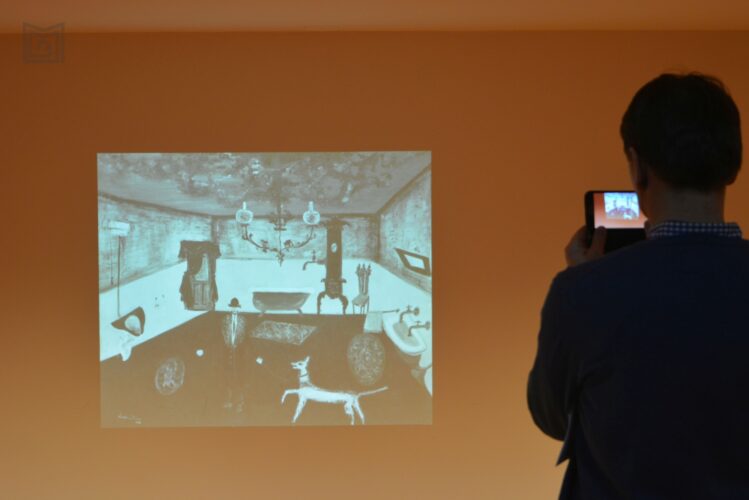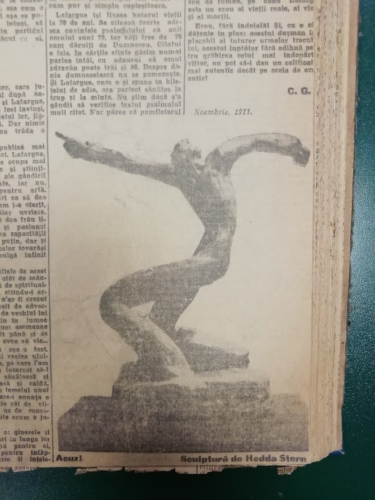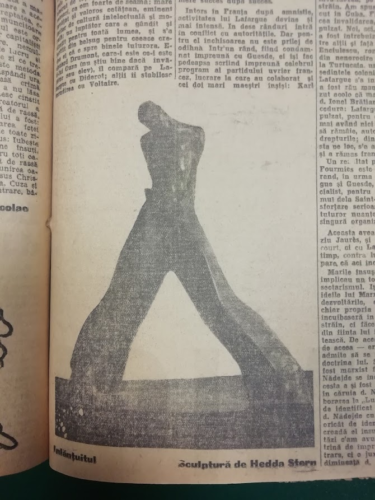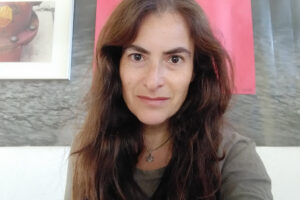War, migration, displacement, and uprooting play an important role in the process of forgetting and erasure even when these are not politically motivated. Interrupted biographies and careers often lead to a fall in obscurity. This is abundantly clear in the case of Hedda Sterne, one of the most promising and talented artists in interwar Romania whose legacy was all but effaced from the art historical canon of her native country.
Born in Bucharest in 1910 as Hedwig Lindenberg, Hedda started taking art classes at an early age with the encouragement of Max Herman Maxy, a former language student of her father´s. Her first teacher, Fritz Storck, one of the most important sculptors and artists of the period, husband of the equally famous painter Cecilia Cutescu Storck, had also been the teacher of Maxy and other artists who would in turn become famous modernists. In this circle, Hedda also got to know the Brauner brothers (Victor, Harry, and Theodore) and Marcel Janco, who would later become her second teacher. Victor and Marcel returned to Bucharest from Zurich where in 1916 they had co-founded with their compatriots, Tristan Tzara and Arthur Segal, the anti-movement Dada at the Cabaret Voltaire. The spirit of this avant-garde was cultivated in Romania through a series of publications – such as Integral, Contimporanul, and 75HP among others – that connected the Bucharest-based group to international circles, fostered exchange, as well as established close relationships. The first sign of appreciation for Hedda´s talents can be found in October 1924 in the only issue of 75HP, one of the most avant-garde of all the above-mentioned publications. On its Dadaistic pages, headlining a review by Ilarie Voronca, is a reproduction of a lithograph dedicated to Hedda made by Victor Brauner for his exhibition at the Maison d´Art. Hedda was only 14. Her friendship with the Brauner brothers, especially Victor, who moved to France in 1938 and survived the war partially in hiding, would last a lifetime. Theodore Brauner, the least known of the three, would eventually join Victor in Paris in 1952 and continue his career as a gifted experimental photographer after escaping the Romanian Holocaust in 1942, having been kept in a transit camp in Cyprus and finally reaching Palestine in 1944. The tragic fate of Harry, a folklorist, is already well-known in Romania. He survived the Holocaust in Bucharest, then, having been tried by the communist regime in the Patrascanu lot in 1950, he was jailed for 12 years, of which 7 he spent in isolation. He married one of his co-defendants in the trial, the artist Lena Constante, after their liberation in 1963.
In 1929 Hedda left Bucharest for Europe’s famous art schools, including the Vienna School of Arts and Crafts and Paris´s Académie de la Grande Chaumière and came back to enrol at the University of Bucharest in 1930. Two years later she married Fritz Sterne, who supported her art career throughout his life, even after their divorce in 1944. During the 1930s she continued visiting Paris where she would meet her friend Victor, a devoted promoter of Hedda´s work among the Surrealist circles of which he was part, helping her to eventually land in the 1938 Salon des Sur-independants. Hedda made her debut in Romania with a 1936 solo sculpture exhibition at Sala Mozart. Of the show, Claudia Millian wrote in Cuvîntul Liber, “In all this plastic confession, one discovers her personal style, an intellectual attitude, a social understanding…” while Adevărul raved, “it´s a dynamic exhibition… the artist is not satisfied with the creation of wonderful, large trinkets, but, with closed fists, she revolts.” Her sculptures were expressive and powerful. The forms were highly stylized yet captured the force of bodies in motion.
In this close-knit group of avant-garde artists of mostly Jewish descent, Sterne met and befriended the painter Medi Wechsler, who first dated Harry Brauner before ultimately settling down with the poet and essayist Stephan Roll (Gheorghe Dinu). It is with Medi that Hedda left the majority of her belongings before fleeing fascist Romania in October 1941 for the safety of America to join her husband Fritz who had left on a business trip the previous year, when some travel from Romania was still possible, and never returned.
In an interview from 2001, Hedda spoke of the antisemitic terror she experienced in those years in Romania, “You see, I remember when I was young, they – if they had money, they hated them. If they didn’t have money, they hated them. If they were intellectual, they hated them. If they were artists, they hated them. No matter what the Jews did, it was a reason to be hated in Romania.” This heavy and dark atmosphere is rendered in a 1939 series of surrealistic aquarelles bordering on the abstract called Bucharest cityscapes. The January 1941 Iron Guard rebellion and anti-Jewish pogrom convinced Hedda and many other Jews, including Marcel Janco, that they must escape. In the same 2001 interview she described those days of the pogrom thus: “It became – it became too, too – a matter of life or, not death. A horrible death. Hideous. I escaped – I had a friend who was a tremendous physical specimen, non-Jew, who spent the nights in my apartment. And one night, there was a [inaudible, 03:18] knock. And he physically, because he was such a good guy, fought them off and saved me. And next morning I heard what happened to the people who had been picked up. I won’t tell you, it’s too horrible.”
Once arrived in New York, she began a series of paintings called Memories of Romania, making use of a surrealist aesthetic and pointing to autobiographical moments. After the completion of the series, which maybe also functioned as a catharsis, she broke her connection to her native country and dedicated herself to a new life in the new world. In 1944 she divorced Fritz Sterne and married artist Saul Steinberg, a fellow Romanian Jew who had arrived in New York in July of 1942 after an even more peripatetic journey to escape fascism and persecution in Europe. With Saul she only spoke English. Slowly moving away from Surrealism, she developed her own personal style, at first embracing the speed, modernity, and industry of New York and representing it in paintings of what she called anthropographs (machines with human-like features).
But unlike her career that blossomed in the United States as she began to frequent and befriend the modernist artists in the European expat community, like Max Ernst, Marcel Duchamp, Peggy Guggenheim, etc., and receive much-deserved recognition – including becoming the only female member of the Irascibles – the mark she had made in Romania perished with the devastation of the war and the post-war political changes. Medi Dinu integrated herself well in the new post-war cultural milieu, and enjoyed a long, flourishing career. She kept Hedda´s belongings safe until old age, when she interned herself at the Moses Rosen Retirement Home. At this time her entire estate was broken up and sold for pennies in questionable circumstances. Her belongings, including works by Sterne, made their way to dealers, antique shops, flea markets or on various used items websites. It seems no art institution at that time was interested in reclaiming Hedda Sterne as part of the canon of the Romanian avant-garde, which had otherwise become such an exportable commodity despite the profound antisemitism that had forced the majority of the artists to flee Romania and disperse around the globe.
The first presentation in Romania of Hedda’s work, with a focus on her pre-emigration years, was made during the Bucharest exhibition of The Future of Memory, a multi-city platform that I founded in 2016 and worked in collaboration with Asociatia Quantic to organize in 2017. While the institutional support to insure the original works on paper, which were extremely delicate, did not come through, images of her work were shown at Casa Cesianu in the show I curated, and the director of the Hedda Sterne Foundation in New York, Shaina Larrivee, came to discuss the artist and her biography. Thus we revived the memory of a marginalized and disregarded, but extraordinary, artist who should be considered as one of the greatest and most gifted Romanian avant-gardists of her time.
POSTED BY
Olga Ștefan
Olga Ștefan is a curator, researcher, arts journalist, and documentary filmmaker. In 2016 she founded the transnational platform for Holocaust Remembrance through Art and Media, The Future of Memory,...
www.olgaistefan.wordpress.com.





2 Comments
It is with pleasure and pain that I read this essay. Some of the recent comments I can confirm since I did witness. And I can testify that Mrs. Ştefan is the first one to courageously publicise them in written form.
On the ‘pleasure’ side, my heart is quickening since, quite by chance, I did meet some of those beautiful people she talks about; and not only in the XXI-st Century (like Medi Dinu-Wechsler, whom I met and been in contact since 2004 until her passing), but also quite early in my life (Peggy Guggenheim, in 1972).
A great piece of writing, Mrs. Ştefan, thank You !
Splendid, and extremely interesting article, full of fascinating details about an almost unknown but great chapter of art history.